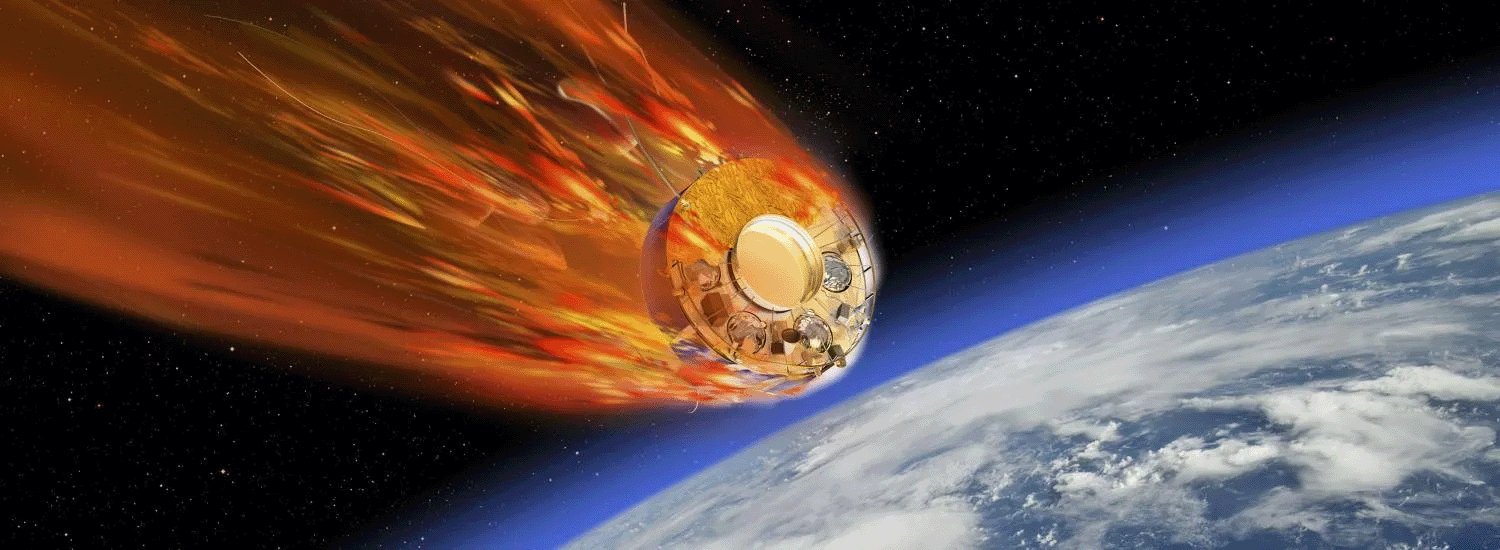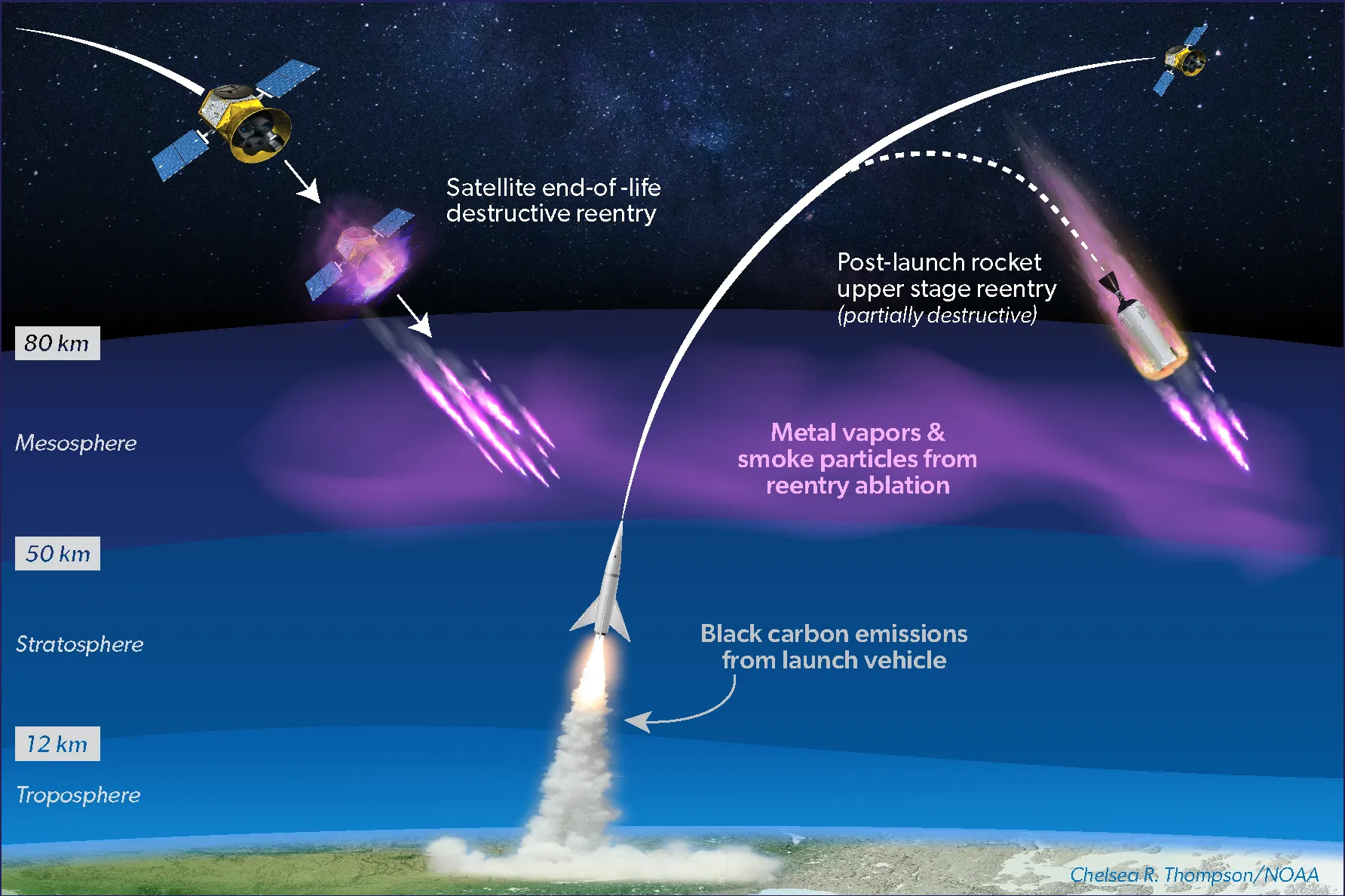2025 News & Events
Within 15 years, plummeting satellites could release enough aluminum to alter winds, temps in the stratosphere
28 April 2025
adapted from the story by CIRES Communications

Estimates suggest satellite debris could rival the amount of naturally occurring meteor dust in the atmosphere by 2040.
When satellites reach the end of their lifetimes, they fall from orbit and burn up in Earth's atmosphere. This litters the stratosphere with metallic aerosol particles like aluminum oxide, or alumina. New research modeling this process suggests that by 2040, there would be enough alumina in the stratosphere to alter wind speeds and temperatures at the poles and impact Earth's climate in ways scientists don't fully understand.
As of now, there are about 5,500 satellites in low Earth orbit (LEO). But constellations of LEO satellites are growing as companies like Starlink increasingly use them to provide broadband internet access. In 2022, the Government Accountability Office estimated there could be more than 60,000 LEO satellites by 2040, each with a lifespan of about five years.
At that rate, a satellite would burn up in the atmosphere every one to two days, depositing 10,000 metric tons of alumina in the upper atmosphere. That's equivalent to about 150 space shuttles vaporizing in the atmosphere every year.
The new study, published in the Journal of Geophysical Research: Atmospheres, suggests that much alumina could alter polar vortex speeds, heat up parts of the mesosphere by as much as 1.5 degrees Celsius, and impact the ozone layer. The metal aerosols and other particles vaporized from falling satellites would likely circulate in the stratosphere for several years, according to the authors.
"What we're showing in this paper is that even from a very crude perspective, there is potential for these reentry aerosols to influence stratospheric and mesospheric processes, whether it's through heating or transport," said Chris Maloney, a CIRES research scientist working at NOAA CSL who led the study.
Today, there are few enough LEO satellites to make an impact on Earth's middle and upper atmosphere. But by 2040, the amount of aerosolized aluminum and other particles could equal the amount of dust that naturally accumulates in the atmosphere from falling meteors.

"If we scale up to these situations where we have these 60,000+ satellites in low Earth orbit, we might actually start influencing the middle atmosphere," Maloney said.
Aluminum is the most abundant material in satellites, but there are very few observations of how aluminum aerosol particles react with other molecules in the stratosphere.
In the new study, Maloney and his colleagues simulated how clouds of alumina vapor could impact Earth's middle and upper atmosphere. They modeled scenarios for different locations on the globe where satellite reentry could happen and also modeled alumina aerosols of different sizes. The size distribution of alumina aerosols plays an important role in how long these particles stay in the atmosphere and how much infrared energy they can absorb or reflect.
Their results show alumina particles could heat the middle atmosphere by about 1.5 degrees Celsius near Earth's poles and reduce wind speeds in the Southern Hemisphere's polar vortex by about 10 percent. The researchers suspect this would help shrink the ozone hole that forms over the South Pole every year, but exactly how alumina affects ozone is still unclear.
Maloney hopes future research campaigns can provide direct observations of alumina in the atmosphere that could offer further insights into how satellite reentry would affect ozone chemistry.
"[This study is a] baby step towards a better understanding," Maloney said. "The idea is hopefully we'll have a better model to do this again with chemistry."
Maloney, C.M., R.W. Portmann, M.N. Ross, and K.H. Rosenlof, Investigating the potential atmospheric accumulation and radiative impact of the coming increase in satellite reentry frequency, Journal of Geophysical Research, doi:10.1029/2024JD042442, 2025.
Abstract
Construction of numerous satellite megaconstellations in the low Earth orbit (LEO) (300–2,000 km) is projected over the coming decades. Estimates suggest that the number of satellites in an LEO could exceed 60,000 by 2040. The increase in the annual mass flux of anthropogenic material into the upper atmosphere as a result of maintaining these megaconstellations could rival the natural occurring meteoric mass flux. Little is known about the aerosols that will be produced by reentry vaporization, which makes estimating the associated impacts on climate and ozone difficult. Aluminum is a primary satellite component that will likely be emitted during reentry vaporization. In this study we simulate a reentry emission of 10 Gg/yr, assuming that all aerosols released is aluminum oxide (Al2O3). This level of Al2O3 emission is consistent with expected megaconstellation growth by 2040. We investigate how the location of atmospheric accumulation, aerosol size distribution, and radiative properties of reentry Al2O3 impacts the middle-to-upper atmosphere. We find that depending on reentry latitude and aerosol size distribution, a 20–40-Gg stratospheric burden of Al2O3 aerosols accumulates poleward of 30 N/S between 10 and 30 km. Small but statistically significant changes in mesospheric heating rates lead to 1.5 K-temperature anomalies in the mesosphere and the stratosphere at Southern Hemisphere high latitudes. These temperature anomalies are accompanied by a 10% reduction in wind speed in the Southern Hemisphere polar vortex, leading to a weaker springtime ozone hole. Some reentry scenarios also experience a strengthening of the Northern Hemisphere polar vortex.